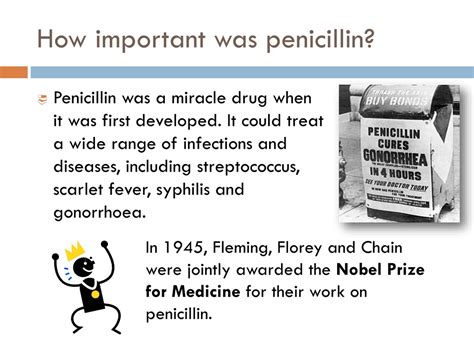Why Is Penicillin Important

Penicillin, a groundbreaking antibiotic discovered in the early 20th century, has revolutionized modern medicine and holds immense significance in the field of healthcare. Its discovery marked a pivotal moment in the battle against infectious diseases, offering a powerful tool to combat bacterial infections and save countless lives. In this article, we delve into the history, mechanism of action, and enduring impact of penicillin, highlighting its importance in the medical landscape.
The Discovery of Penicillin: A Medical Breakthrough

The story of penicillin’s discovery is a fascinating chapter in the history of medicine. In 1928, Dr. Alexander Fleming, a Scottish bacteriologist, made an accidental yet momentous discovery. Upon returning from a vacation, he noticed that a mold (Penicillium notatum) had contaminated one of his bacterial cultures, leading to the inhibition of bacterial growth. This observation sparked the idea that the mold produced a substance with antibacterial properties.
Dr. Fleming's initial experiments confirmed the mold's ability to kill certain bacteria, including the staphylococcus bacteria. He named this substance penicillin, derived from the genus name of the mold. However, it took another decade for penicillin to be purified and clinically tested, thanks to the efforts of Ernst Chain and Howard Florey, who worked with Fleming to develop the antibiotic further.
Mechanism of Action: How Penicillin Fights Infections

Penicillin belongs to a class of antibiotics known as beta-lactam antibiotics, which target bacterial cell wall synthesis. When bacteria multiply, they build new cell walls to enclose the newly formed cells. Penicillin interferes with this process by inhibiting the enzymes responsible for cell wall synthesis, specifically the enzyme transpeptidase.
Without a functional cell wall, bacteria become susceptible to osmotic pressure and eventually lyse (burst). This mechanism of action makes penicillin highly effective against a wide range of gram-positive bacteria, including those causing infections such as pneumonia, meningitis, and syphilis.
Penicillin’s Spectrum of Activity
Penicillin’s effectiveness is not limited to a single type of infection. Its spectrum of activity covers various gram-positive bacteria, making it a versatile antibiotic. However, it is less effective against gram-negative bacteria, which have a different cell wall structure. To address this, scientists have developed derivatives of penicillin, known as semisynthetic penicillins, which have an expanded spectrum of activity.
| Type of Penicillin | Spectrum of Activity |
|---|---|
| Natural Penicillins | Effective against most gram-positive bacteria |
| Semisynthetic Penicillins | Broader spectrum, including some gram-negative bacteria |

Clinical Applications and Impact on Healthcare
The introduction of penicillin into clinical practice brought about a paradigm shift in the treatment of infectious diseases. Prior to penicillin, bacterial infections often led to severe complications and high mortality rates. With penicillin, physicians gained a powerful tool to combat these infections and save lives.
Treatment of Infections
Penicillin has proven effective in treating a wide range of infections, including:
- Pneumonia caused by Streptococcus pneumoniae
- Skin and soft tissue infections
- Infective endocarditis
- Gonorrhea
- Syphilis
Saving Lives in Warfare
During World War II, penicillin played a crucial role in saving the lives of wounded soldiers. Its ability to treat infections rapidly and effectively reduced mortality rates significantly. The development and mass production of penicillin during the war had a profound impact on military medicine and public health.
The Birth of Antibiotic Therapy
The success of penicillin paved the way for the development of other antibiotics and the birth of antibiotic therapy. Scientists began to explore and discover new antibiotics, leading to a diverse range of medications to combat bacterial infections. This advancement in medicine has significantly improved healthcare outcomes and increased life expectancy worldwide.
Challenges and the Future of Penicillin
While penicillin remains a cornerstone of antibiotic therapy, it faces challenges in the era of antimicrobial resistance. The overuse and misuse of antibiotics have led to the emergence of resistant bacterial strains, making some infections difficult to treat.
Antimicrobial Resistance
The widespread use of penicillin and other antibiotics has contributed to the development of antibiotic-resistant bacteria. These bacteria have evolved mechanisms to survive antibiotic treatment, rendering certain antibiotics less effective. To address this challenge, researchers are exploring new strategies, such as developing combination therapies and discovering novel antibiotics.
Future Prospects
Despite the challenges, penicillin and its derivatives continue to play a vital role in modern medicine. Researchers are constantly working to improve our understanding of antibiotic resistance and develop innovative solutions. Additionally, the discovery of new antibiotic compounds and the exploration of alternative treatments, such as phage therapy, offer promising avenues for combating antibiotic-resistant infections.
Conclusion

Penicillin’s discovery and subsequent development marked a turning point in the fight against infectious diseases. Its ability to combat bacterial infections has saved countless lives and shaped the course of modern medicine. While challenges such as antimicrobial resistance persist, penicillin remains a cornerstone of antibiotic therapy, and ongoing research strives to ensure its continued effectiveness in the face of evolving bacterial threats.
How does penicillin work as an antibiotic?
+Penicillin works by inhibiting the synthesis of bacterial cell walls. It interferes with the enzymes responsible for building the cell wall, leading to the breakdown of the wall and the subsequent death of the bacteria.
Is penicillin still effective today?
+Yes, penicillin remains an important antibiotic in modern medicine. However, due to the emergence of antibiotic-resistant bacteria, it may not be as effective against certain strains. Researchers are continuously working on developing new antibiotics and strategies to combat resistance.
What are the common side effects of penicillin?
+Penicillin is generally well-tolerated, but some individuals may experience side effects such as nausea, vomiting, diarrhea, and allergic reactions. It is important to inform your healthcare provider if you have a history of penicillin allergy or experience any adverse reactions while taking the medication.



